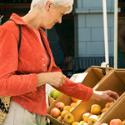Locally Grown Food

Locally grown food is just what it sounds like: food that's grown near where you live. Buying food from within your community can help preserve habitat for wildlife, save energy, and improve your local economy. 
-
Community Supported Agriculture
Community Supported Agriculture consists of one or more farmers and many individuals or families from the community who pledge financial support to a farm operation. The farmers and consumers provide mutual support and share the risks and benefits of food production.
Typically, members (or "share-holders" of the farm) pledge in advance to cover the anticipated costs of the farm operation and farmer's salary. In return, they receive “shares” or a regular portion of the harvest from the farm's bounty throughout the growing season, as well as satisfaction gained from reconnecting to the land and participating directly in food production. Members also share in the risks of farming, including poor harvests due to unfavorable weather or pests.
By direct sales to community members (who have provided the farmer with working capital in advance) growers receive better prices for their crops, gain some financial security, and are relieved of much of the burden of marketing. Members benefit because they receive a wide diversity of fresh, local produce harvested at the peak of freshness and flavor.
-
Energy Conservation
Buying locally grown foods decreases dependence on petroleum - a non-renewable energy source. One-fifth of all petroleum used in the United States is used in agriculture. Some statistics show that the average distance food travels in distribution is 1,500 miles. By learning to eat foods that are locally available and in season, families can do their part to save energy. By buying local, you can conserve the large amount of energy used in both the packaging and shipping of food.
-
Why Buy Locally Grown?
Consumers worldwide are rediscovering the benefits of buying locally grown food. It is fresher, tastier, and more nutritious. It is also good for the local economy. Buying directly from family farmers helps them stay in business.
Five Reasons to Buy Local
1) Local produce tastes better and it’s better for you
Studies have shown that fresh produce loses nutrients quickly during transportation. During the trip from harvest to dinner table, sugars turn to starches, plant cells shrink, and produce loses its vitality. Food grown in your own community was probably picked within the past day or two, and therefore is much fresher.
2) Local food supports local farm families
Fewer than one million Americans now claim farming as their primary occupation (less than one percent). Farming is a vanishing lifestyle. That's not surprising, considering that today's farmer gets less than 10 cents of the retail food dollar. Local farmers who sell directly to consumers cut out the many middle people and get full retail price for their food. That means farm families can afford to stay on the farm, doing the work they love.
3) Local food protects genetic diversity
In the modern industrial agriculture system, produce varieties are chosen for their ability to ripen simultaneously and withstand harvesting equipment. Shippers demand produce with a tough skin that can survive packing, transport, and a long shelf life in the store. Only a handful of hybrid varieties of each fruit and vegetable meet those rigorous demands, so there is little genetic diversity in the plants grown. By contrast, local farmers that sell direct to you or direct to your local restaurants and grocery stores grow a huge number of varieties selected because they have the best flavors, provide a long harvest season, and come in an array of eye-catching colors. Many varieties are heirlooms, passed down from generation to generation because they taste good. These old varieties contain genetic material from hundreds or even thousands of years of human selection. They may someday provide the genes needed to adapt to a changing climate or new pests.
4) Local food preserves open space and can support a diverse environment
As the value of direct-marketed fruits and vegetables increases, selling farmland for development becomes less likely. The patchwork of fields, hedgerows, ponds and buildings can serve as habitat for many species of wildlife. That landscape will survive only as long as farms are financially viable. When you buy locally grown food, you are doing something proactive about preserving the agricultural landscape.
5) Local food is about the future
By supporting local farmers today, you can help ensure there will be farms in your community tomorrow, that there will be green space for wildlife, and that future generations will have access to locally grown food.
Additional Resources
- UF/IFAS Center for Organic Agriculture
- Organic Certification | Florida Dept of Agriculture and Consumer Services
- Florida Certified Organic Growers and Consumers
- National Organic Program | AMS USDA
- National Sustainable Agriculture Information Services (ATTRA)
- Organic Publications on ATTRA
- Organic Farming Research Foundation
- Sustainable Agriculture Research and Education
- Local Harvest - Find locally-grown food near you



